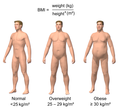Classification of obesity
Classification of Obesity
Obesity is a complex, chronic disease characterized by excessive body fat accumulation that presents significant risks to health and well-being. The classification of obesity is crucial for understanding its severity, potential health implications, and guiding treatment strategies. This article provides a comprehensive overview of the current methods used to classify obesity, focusing on body mass index (BMI), waist circumference, and body fat percentage.
Body Mass Index (BMI)[edit]
Body Mass Index (BMI) is the most widely used method for classifying obesity. It is calculated by dividing a person's weight in kilograms by the square of their height in meters (kg/m²). The World Health Organization (WHO) categorizes BMI into the following classes:
- Underweight: BMI less than 18.5
- Normal weight: BMI 18.5 to 24.9
- Overweight: BMI 25 to 29.9
- Obesity class I (Moderate obesity): BMI 30 to 34.9
- Obesity class II (Severe obesity): BMI 35 to 39.9
- Obesity class III (Very severe or morbid obesity): BMI 40 or higher
Waist Circumference[edit]
Waist circumference is another important measure used to classify obesity, particularly because it provides an estimate of abdominal fat, which is a predictor of risk for obesity-related diseases. High waist circumference can indicate a higher risk of type 2 diabetes, dyslipidemia, hypertension, and cardiovascular disease. The risk levels associated with waist circumference vary by sex and ethnicity, but general guidelines suggest:
- For men: High risk is a waist circumference of 102 cm (40 inches) or more.
- For women: High risk is a waist circumference of 88 cm (35 inches) or more.
Body Fat Percentage[edit]
Body fat percentage is considered by many health professionals to be a more accurate measure of obesity than BMI, as it distinguishes between body fat and muscle mass. However, measuring body fat percentage accurately can be challenging and often requires specialized equipment. Methods such as bioelectrical impedance analysis (BIA), dual-energy X-ray absorptiometry (DXA), and skinfold measurements are commonly used. Although there is no universally accepted classification for obesity based on body fat percentage, the American Council on Exercise provides the following general guidelines:
- Essential fat: 10-13% (women), 2-5% (men)
- Athletes: 14-20% (women), 6-13% (men)
- Fitness: 21-24% (women), 14-17% (men)
- Acceptable: 25-31% (women), 18-24% (men)
- Obesity: >32% (women), >25% (men)
Treatment and Management[edit]
The classification of obesity is a critical step in determining the most appropriate treatment and management strategies. These may include lifestyle modifications, such as diet and exercise, pharmacotherapy, and in some cases, bariatric surgery. Early intervention and personalized treatment plans are essential for effectively managing obesity and reducing the risk of associated health conditions.
Conclusion[edit]
The classification of obesity using BMI, waist circumference, and body fat percentage provides valuable insights into an individual's health status and risks. It is important for healthcare professionals to use these measures in conjunction to obtain a comprehensive understanding of an individual's obesity and related health risks. Ongoing research and advancements in measuring and classifying obesity will continue to improve the accuracy and effectiveness of obesity management strategies.
-
Obesity and BMI chart
-
Classification of obesity
-
CT scan showing fat distribution
Ad. Transform your life with W8MD's Budget GLP-1 injections from $75


W8MD offers a medical weight loss program to lose weight in Philadelphia. Our physician-supervised medical weight loss provides:
- Weight loss injections in NYC (generic and brand names):
- Zepbound / Mounjaro, Wegovy / Ozempic, Saxenda
- Most insurances accepted or discounted self-pay rates. We will obtain insurance prior authorizations if needed.
- Generic GLP1 weight loss injections from $75 for the starting dose.
- Also offer prescription weight loss medications including Phentermine, Qsymia, Diethylpropion, Contrave etc.
NYC weight loss doctor appointmentsNYC weight loss doctor appointments
Start your NYC weight loss journey today at our NYC medical weight loss and Philadelphia medical weight loss clinics.
- Call 718-946-5500 to lose weight in NYC or for medical weight loss in Philadelphia 215-676-2334.
- Tags:NYC medical weight loss, Philadelphia lose weight Zepbound NYC, Budget GLP1 weight loss injections, Wegovy Philadelphia, Wegovy NYC, Philadelphia medical weight loss, Brookly weight loss and Wegovy NYC
|
WikiMD's Wellness Encyclopedia |
| Let Food Be Thy Medicine Medicine Thy Food - Hippocrates |
Medical Disclaimer: WikiMD is not a substitute for professional medical advice. The information on WikiMD is provided as an information resource only, may be incorrect, outdated or misleading, and is not to be used or relied on for any diagnostic or treatment purposes. Please consult your health care provider before making any healthcare decisions or for guidance about a specific medical condition. WikiMD expressly disclaims responsibility, and shall have no liability, for any damages, loss, injury, or liability whatsoever suffered as a result of your reliance on the information contained in this site. By visiting this site you agree to the foregoing terms and conditions, which may from time to time be changed or supplemented by WikiMD. If you do not agree to the foregoing terms and conditions, you should not enter or use this site. See full disclaimer.
Credits:Most images are courtesy of Wikimedia commons, and templates, categories Wikipedia, licensed under CC BY SA or similar.
Translate this page: - East Asian
中文,
日本,
한국어,
South Asian
हिन्दी,
தமிழ்,
తెలుగు,
Urdu,
ಕನ್ನಡ,
Southeast Asian
Indonesian,
Vietnamese,
Thai,
မြန်မာဘာသာ,
বাংলা
European
español,
Deutsch,
français,
Greek,
português do Brasil,
polski,
română,
русский,
Nederlands,
norsk,
svenska,
suomi,
Italian
Middle Eastern & African
عربى,
Turkish,
Persian,
Hebrew,
Afrikaans,
isiZulu,
Kiswahili,
Other
Bulgarian,
Hungarian,
Czech,
Swedish,
മലയാളം,
मराठी,
ਪੰਜਾਬੀ,
ગુજરાતી,
Portuguese,
Ukrainian


